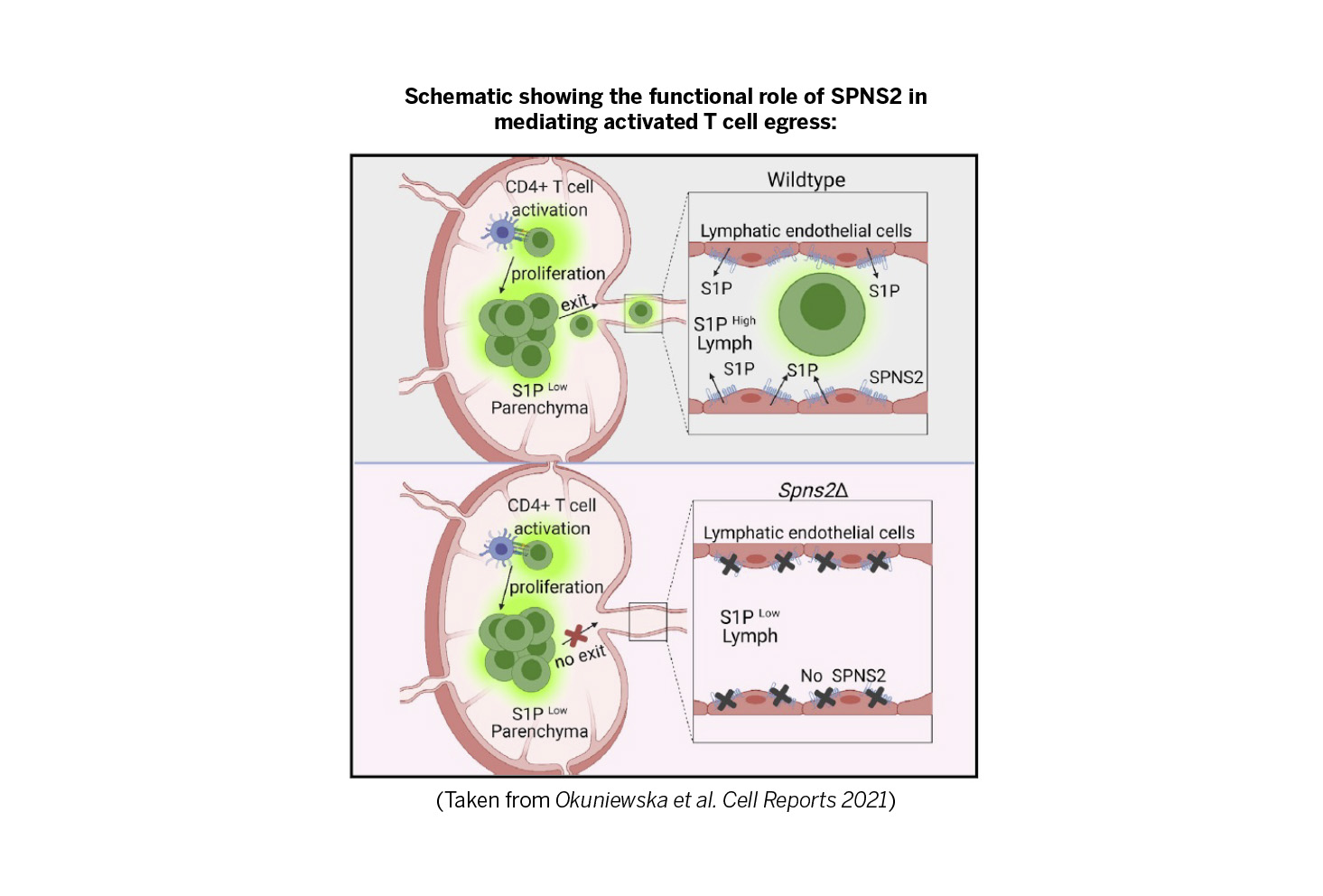Small Molecule Inhibitors of SPNS2 for the Treatment of Chronic Inflammatory Diseases

Technology
The Schwab Lab at NYU Langone Health has elucidated a new therapeutic strategy for the treatment of chronic inflammatory diseases by trapping activated lymphocytes and achieving immunosuppression through the manipulation of sphingosine 1-phosphate (S1P) gradients rather than conventional S1P receptor 1 (S1PR1) targeting. In previous work (Okuniewska et al. Cell Reports 2021), they discovered that the transporter protein Spinster homolog 2 (SPNS2) is responsible for exporting S1P into the lymph guiding T cell egress from the lymph nodes (LN) during an immune response (see schematic). As discussed in the paper, this result immediately suggested that pharmacological inhibition of SPNS2 could downregulate S1P gradients resulting in the sequestration of activated T cells in the LN and prevention of subsequent inflammatory reactions and tissue damage. In target validation studies, they found that genetic deletion of Spns2 is protective in a mouse model of multiple sclerosis. These proof-of-concept data strongly suggest that SPNS2 is a novel target for treating chronic inflammatory diseases and offers an innovative therapeutic avenue for achieving immunosuppression without common risks for adverse off-target effects.
As of present, the NYU inventors have identified and preliminarily characterized several small molecule inhibitors of SPNS2 as early therapeutic leads for the treatment of chronic inflammatory diseases. These compounds were initially identified from a 250,000-compound library and later selected for favorable activity in dose-dependent SPNS2 inhibition assays. The current lead candidate shows promising efficacy in mouse T cell sequestration experiments: lowers S1P levels (by ~25%) and reduces T cell counts (by ~60%) when administered daily (QD dosing).
Background
Chronic inflammatory diseases, which represent the most significant cause of death worldwide, are a result of aberrant immune system function and include a vast array of disorders/conditions characterized by long-term inflammation, such as heart disease, diabetes, inflammatory bowel disease (IBD), and multiple sclerosis (MS). New therapeutic strategies to treat chronic inflammatory diseases through suppression of lymphocyte-mediated inflammation and tissue damage are of critical importance to public health. In the immune system, the signaling lipid sphingosine 1-phosphate (S1P) directs the migration of lymphocytes from the lymph nodes (LN) into the lymph by binding and activating S1P receptor 1 (S1PR1) on the surface of lymphocytes. Several FDA-approved drugs target S1PR1 as a mechanism to sequester lymphocytes in the LN and cause immunosuppression; however, this therapeutic strategy suffers from adverse off-target effects due to the pleiotropic functions of S1PR1, specifically in the cardiovascular system.
Current Development Stage
Hit-to-lead optimization: Small molecule inhibitors of SPNS2 have been confirmed in primary and counter screens and profiled for dose-dependent activity. Several lead candidates have been selected for further optimization and characterization.
Applications
- Treatment of chronic inflammatory diseases:
- Crohn’s disease
- Ulcerative colitis (UC)
- Inflammatory bowel disease (IBD)
- Autoimmune encephalitis
- Relapsing remitting multiple sclerosis (RRMS)
- Idiopathic Thrombocytopenic Purpura (ITP)
- Fibrosis
- Other autoimmune diseases
Advantages
- Differentiated therapeutic strategy for modulating S1P signaling: SPNS2 inhibition downregulates extracellular S1P gradients without directly manipulating the S1P receptor (S1PR1), the conventional target for existing FDA-approved therapeutics.
- Low apparent risk for adverse off-target effects common with existing S1P modulating agents: Unlike S1PR1, SPNS2 does not play critical functional roles in the cardiovascular system.
- Spatially-specific mechanism of action: SPNS2 inhibition targets S1P signaling gradients in the lymph and causes spatially-specific lymphocyte trapping within the lymph nodes.
- Extensively validated target: SPNS2 is well-characterized S1P transporter that exports S1P into the lymph guiding T cell egress from the lymph nodes during an immune response.
- Target topology is favorable for pharmacological intervention: SPNS2 is a membrane-embedded transporter with extracellular exposed surface (substrate binding pocket and interhelical loops) accessible to extracellular drug targeting.
Intellectual property
A PCT patent application has been filed covering the chemical compositions of the identified SPNS2 inhibitors and their methods of use.
-
expand_more mode_edit Authors (1)Susan Schwab, PhD
-
expand_more library_books References (2)
- Okuniewska M, Fang V, Baeyens A, Raghavan V, Lee JY, Littman DR, Schwab SR , SPNS2 enables T cell egress from lymph nodes during an immune response
- Mendoza A, Bréart B, Ramos-Perez WD, Pitt LA, Gobert M, Sunkara M, Lafaille JJ, Morris AJ, Schwab SR. , The transporter Spns2 is required for secretion of lymph but not plasma sphingosine-1-phosphate
-
expand_more cloud_download Supporting documents (2)Product brochureSmall Molecule Inhibitors of SPNS2 for the Treatment of Chronic Inflammatory Diseases.pdfMarketing BriefNYU-SPNS2-Marketing Brief - SCH14-01.pdf (314 KB)